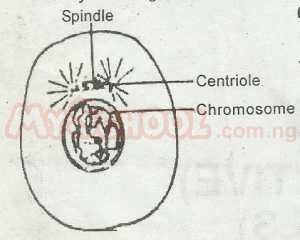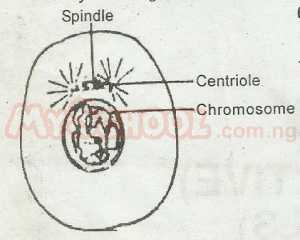Year :
1988
Title :
Biology
Exam :
WASSCE/WAEC MAY/JUNE
Paper 1 | Objectives
1 - 10 of 53 Questions
| # | Question | Ans |
|---|---|---|
| 1. |
 What stage mitotic division is represented in the diagram of the cell illustrated above? A. Prophase B. Telophase C. Anaphase D. Metaphase E. Interphase |
A |
| 2. |
 This stage of mitosis is characterized by the A. movement of the chromosome to the poles B. arrangement of chromosomes on the equitorial planes C. centromeres moving apart along the spindle D. interaction of the spindles with the chromosomes E. condensation of chromosomes and formation of spindles |
E |
| 3. |
The ability of organisms to maintain a constant internal environment is known as A. diuresis B. endosmosis C. plasmolysis D. dialysis E. homeostasis |
E |
| 4. |
Double fertilization is said to occur in flowering pants because A. two embryos are formed B. one egg is fertilized twice C. two sperms fertilize each egg D. one embryo and endosperm nucleus are formed E. two sperms and two pollen grains are involved |
D |
| 5. |
The bicuspid valve is located between the A. left auricle and left ventricle B. aorta and left ventricle C. superior vena cava and inferior vena cava D. right auricle and superior vena cava E. right auricle and right ventricle |
A |
| 6. |
The pulmonary artery carries A. deoxygenated blood from the right ventricles to the lungs B. oxygenated blood from the right ventricle to the lungs C. oxygenated blood from the left ventricles to the ventricles to the right auricle D. deoxygenated blood from the left ventricles to the right auricles E. oxygenated blood from the lings to the right auricles |
A |
| 7. |
Which of the following blood components has the greatest affinity for oxygen and carbondioxide? A. Blood plasma B. Leucocytes C. Thrombocytes D. Erythrocytes E. Lymphocytes |
D |
| 8. |
The thoracic cavity is separated from the abdominal cavity by a sheet of muscle called A. pleural membrane B. intercostal muscles C. diaphragm D. pericardium E. epiglottis |
C |
| 9. |
Deamination is the process during which A. excess amino acid is broken down into ammonia and keto acid B. fats and oil are converted into an emulsion for absorption C. excess glucose is converted and store as glycogen in the liver D. glycogen is reconverted into glucose through the action of glucagon E. excess amino acid is converted into proteins |
A |
| 10. |
Which of the following statements on urine production is not correct? A. Concentrated urine is produced under the control of antidiuretic hormone B. The total volume of urine produced depends on the need for water excretion C. if there is excess intake of water, dilute urine is expected D. if there is a shortage of water in the body the volume of the urine produced is decreased E. in the presence of antidiuretic hormone dilute urine is produced Detailed Solution- Antidiuretic hormone binds to receptors on cells in the collecting ducts of the kidney and promotes reabsorption of water back into the circulation.- Its most important role is to conserve the fluid volume of your body by reducing the amount of water passed out in the urine. |
| 1. |
 What stage mitotic division is represented in the diagram of the cell illustrated above? A. Prophase B. Telophase C. Anaphase D. Metaphase E. Interphase |
A |
| 2. |
 This stage of mitosis is characterized by the A. movement of the chromosome to the poles B. arrangement of chromosomes on the equitorial planes C. centromeres moving apart along the spindle D. interaction of the spindles with the chromosomes E. condensation of chromosomes and formation of spindles |
E |
| 3. |
The ability of organisms to maintain a constant internal environment is known as A. diuresis B. endosmosis C. plasmolysis D. dialysis E. homeostasis |
E |
| 4. |
Double fertilization is said to occur in flowering pants because A. two embryos are formed B. one egg is fertilized twice C. two sperms fertilize each egg D. one embryo and endosperm nucleus are formed E. two sperms and two pollen grains are involved |
D |
| 5. |
The bicuspid valve is located between the A. left auricle and left ventricle B. aorta and left ventricle C. superior vena cava and inferior vena cava D. right auricle and superior vena cava E. right auricle and right ventricle |
A |
| 6. |
The pulmonary artery carries A. deoxygenated blood from the right ventricles to the lungs B. oxygenated blood from the right ventricle to the lungs C. oxygenated blood from the left ventricles to the ventricles to the right auricle D. deoxygenated blood from the left ventricles to the right auricles E. oxygenated blood from the lings to the right auricles |
A |
| 7. |
Which of the following blood components has the greatest affinity for oxygen and carbondioxide? A. Blood plasma B. Leucocytes C. Thrombocytes D. Erythrocytes E. Lymphocytes |
D |
| 8. |
The thoracic cavity is separated from the abdominal cavity by a sheet of muscle called A. pleural membrane B. intercostal muscles C. diaphragm D. pericardium E. epiglottis |
C |
| 9. |
Deamination is the process during which A. excess amino acid is broken down into ammonia and keto acid B. fats and oil are converted into an emulsion for absorption C. excess glucose is converted and store as glycogen in the liver D. glycogen is reconverted into glucose through the action of glucagon E. excess amino acid is converted into proteins |
A |
| 10. |
Which of the following statements on urine production is not correct? A. Concentrated urine is produced under the control of antidiuretic hormone B. The total volume of urine produced depends on the need for water excretion C. if there is excess intake of water, dilute urine is expected D. if there is a shortage of water in the body the volume of the urine produced is decreased E. in the presence of antidiuretic hormone dilute urine is produced Detailed Solution- Antidiuretic hormone binds to receptors on cells in the collecting ducts of the kidney and promotes reabsorption of water back into the circulation.- Its most important role is to conserve the fluid volume of your body by reducing the amount of water passed out in the urine. |